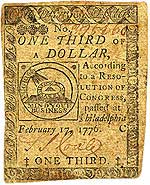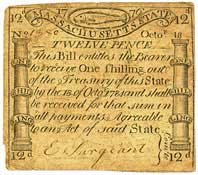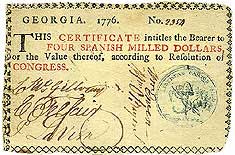|

Continental Currency, one-third dollar,1776
Benjamin Franklin printed this note, which was issued to finance the American Revolution. Backed solely by the promise of tax revenues upon victory, "Continentals" were quickly devalued, leading to the popular expression, "not worth a Continental."

Colonial Currency, Massachusetts, 12 pence, 1776
Paul Revere engraved this note from the Massachusetts Bay Colony. An image of a codfish, which symbolized prosperity for the Massachusetts fisheries, is depicted on the front side of the note. 
Colonial Currency, Georgia, $4, 1776
The Spanish Milled Dollar was the most common denomination used in Colonial currency. More plentiful than British pounds, Spanish Milled Dollars became the unofficial denomination in the colonies.
|



